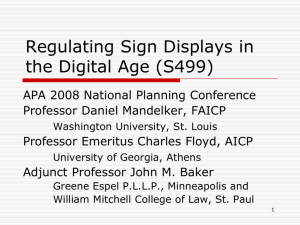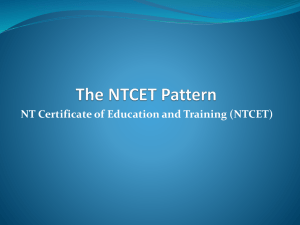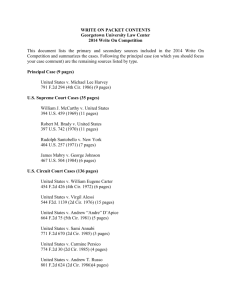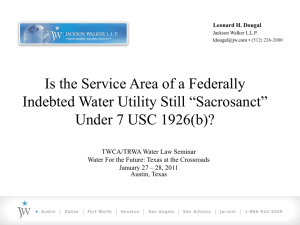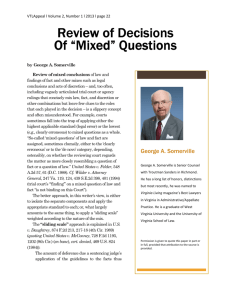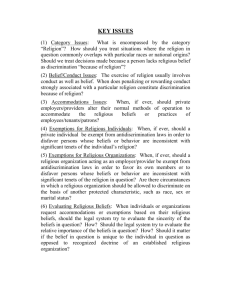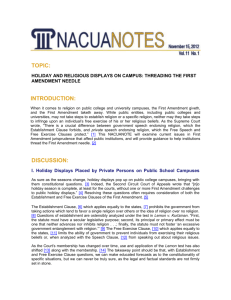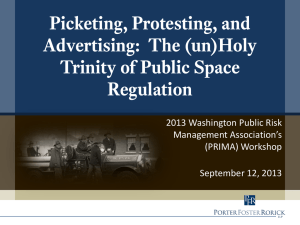Managing Billboards in the Digital Age (S525)
advertisement
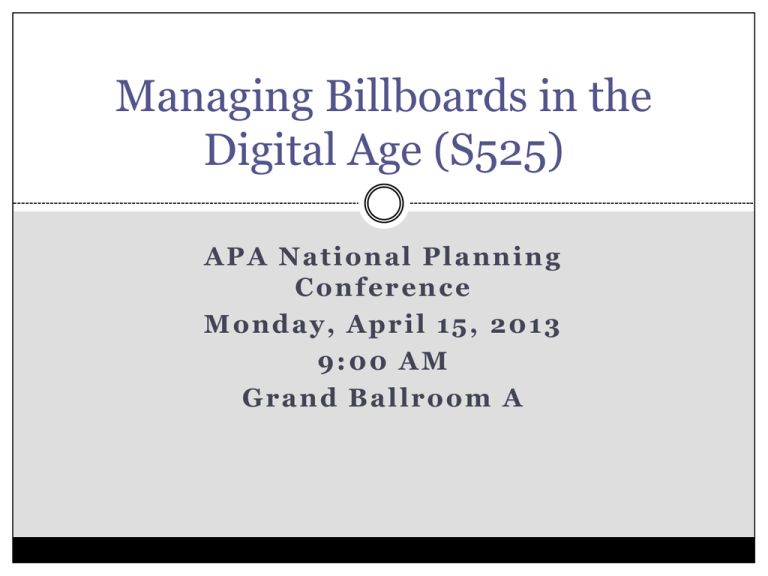
Managing Billboards in the Digital Age (S525) APA National Planning Conference Monday, April 15, 2013 9:00 AM Grand Ballroom A Overview New sign technologies Key regulatory issues raised by those technologies Issues you should look for in sign regulation Some “best practices” to include in a sign code regulating new technologies Continuing education credits for this session Credits approved thus far: For attorneys: 1.25 Illinois Minimum CLE credits For architects:1.25 American Institute of Architects LU/HSW credits To seek ALI/LU credits, remember to complete the signin sheet at the back of the room New sign technologies Examples: digital billboards Current technology: LED (Liquid Crystal Display) screens Capable of full-motion video, but commonly used for sequential static displays The future: low-power displays reflecting ambient light Examples: full-motion video displays Signs, or portions of signs, that effectively function as big-screen television monitors Usually, these appear in non-regulated areas Examples: Multiple, synchronized, displays In a “Times Square” type setting, presentation of a message through several coordinated displays Examples: interactive features In especially permissive locations, the information on the display depends on the actions of viewers One goal: personalized messaging An essential element: rapid display changes http://youtu.be/RJSlbwx tVMc Key regulatory issues Whether, and under what conditions, to permit motion, animation, or video messages The minimum interval between display changes The appropriate level of brightness The appropriate placement and spacing of signs Whether to treat on-site and off-site signs differently Size: size of signs, and size of sign text Whether to prohibit the most distracting uses, such as texting contests and dialing full-length phone numbers Old rationales, and new technologies: safety Courts have long recognized that – Billboards can distract drivers, and Cities can regulate (or even ban) billboards for that reason Legitimate sign studies form pieces of a broader puzzle They support the conclusion that replacement of static signs with frequently-changing dynamic signs can create an added safety hazard See “LED and Video Display Signs” by Marya Morris, at http://law.wustl.edu/landuselaw/powerpoint/Digital%20Sign s%20Marya%20Morris.ppt Old rationales, new technologies: safety “It is a given that a billboard can constitute a traffic hazard. It follows that EMCs, which provide more visual stimuli than traditional signs, logically will be more distracting and more hazardous.” Naser Jewelers v. City of Concord, N.H., 513 F.3d 27, 35 (1st Cir. 2008) Old rationales, new technologies: aesthetics “it would seem well within the City’s legitimate discretion to conclude that bright, colorful, electronic signs that change color and messages – or signs similar to those, are inconsistent with the aesthetic values the City seeks to promote.” Naser Jewelers Inc. v. City of Concord, N.H., 2007 WL 1847307 (D.N.H. June 25, 2007) (district court decision, later affirmed) Issues you should look for in sign regulation Even if the regulation is content-neutral, does the justification satisfy the proper tests? Regulation of commercial speech: Is the asserted governmental interest substantial? If so, does the regulation directly advance the governmental interest asserted? If so, is it not more extensive than is necessary to serve that interest? Central Hudson Gas & Elec. Corp. v. Public Service Comm’n, 447 U.S. 557 (1980) Issues you should look for in sign regulation Even if the regulation is content-neutral, does the justification satisfy the proper tests? Test for time, place, and manner regulations: Is the regulation justified without reference to the content of the regulated speech? If so, is it narrowly tailored to serve a significant government interest? If so, does it leave open ample alternative channels for communication of the information? Ward v. Rock Against Racism, 491 U.S. 781 (1989) Issues you should look for in sign regulation Content-neutrality: Judges can’t agree on a single test for content-neutrality Some ask: has the government adopted the regulation because of its disagreement with the message it conveys? (Ward) Others ask: do you need to consider what the sign says in order to determine the sign’s legality? Solantic LLC v. Neptune Beach, 410 F.3d 1250 (11th Cir. 2005) (SC, FL, GA, AL) Issues you should look for in sign regulation Content-neutrality: Still others ask: Is it a regulation of the places where some speech may occur, rather than a regulation of speech? Was it not adopted because of disagreement with the message the speech conveys? Are the government’s interest unrelated to the content of the affected speech? If any of the three are true, the 4th Circuit (MD, VA, DE, NC) would consider the law content-neutral. Wag More Dogs LLC v. Cozart, 680 F.3d 359 (4th Cir. 2012) Issues you should look for in sign regulation The importance of self-restraints on how, or when, discretion is exercised on permit applications First Amendment law in sign cases is rooted in “parade permit” cases from the 1960s, which recognize that undue discretion or delay can suppress valuable speech Reserving too much discretion may be fatal to the code The absence of any reasonable time-limit for approval or denial may also be problematic “Best practices” Ideas for planners and public lawyers when drafting and adopting zoning ordinances related to new sign technologies, a n d w h e n r e s p o n d i ng t o a p p l i c a t io n s f o r s u c h u s e s 1. Include an effective purpose statement Not just “to protect the health, welfare, safety . . . .” A statement that – Tracks objectives courts view as legitimate, Shows respect for citizens’ need for self-expression, and Will assist your city to justify all distinctions between legal and illegal signs. 1. Include an effective purpose statement Don’t just recite the purposes of restricting these kinds of signs If your ordinance exempts certain types of signs from a restriction, recite objectives that are furthered by those exceptions. The purposes should be unrelated to sign content Often-omitted lawful objectives Objectives for restrictions and prohibitions Eliminating visual clutter Reducing the number and types of distractions experienced by drivers Channeling commercial activity to commercially-zoned areas Often-omitted lawful objectives Objectives for exceptions Way-finding Furthered by exemptions for off-site directional signs Furthered by allowing on-premise signs where off-premise signs are disallowed, particularly if a portion of the message is not allowed to change Enabling the exercise of the most fundamental property rights Furthered by allowing at least one yard sign, and signs on real and personal property that is for sale, even in a residential zone 2. Do not reserve too much discretion Do not authorize denial of a permit even if the application satisfies all of the specific requirements Do not make digital displays subject to generic conditional use permit criteria in the zoning ordinance. If you allow a local board to exempt a sign from the standards – Do not use ordinary “variance” provisions, because they are probably too general, and sometimes open-ended Ensure that your criteria for those exemptions are specific, content-neutral, and tied to stated objectives Poor approval criteria A sign permit would issue only if a sign will not have a harmful effect upon the health or welfare of the general public, and will not be detrimental to the welfare of the general public, and will not be detrimental to the aesthetic quality of the community or the surrounding land uses. Desert Outdoor Adv. v. City of Moreno Valley, 506 F.3d 798 (9th Cir. 2007) Better approval criteria The city may deny permits only when – A sign does not comply with reasonably specific size and type criteria, or Is not compatible (explicitly defined) with the surrounding environment (explicitly defined) This sign code limited the scope of review to the sign’s relationship with other nearby signs, other elements of street and site furniture, and with adjacent structures. G.K. Ltd. Travel v. City of Lake Oswego, 436 F.3d 1064 (9th Cir. 2006) 3. Set sound time-limits to act on applications Include in your sign code a self-imposed, formal time limit on the ability of staff (or a board or council) to refrain from acting on the application or on an appeal These may be required unless you’re sure that no judge will consider your sign code content-based, or require a time limit regardless of content-neutrality Resources “Free Speech Law for On Premise Signs,” available as a free download at http://landuselaw.wustl.edu/ “The Modern Tower of Babel: Defending the New Wave of First Amendment Challenges to Municipal Billboard and Sign Regulations,” Planning and Environmental Law Vol. 58, No. 10. Questions?
